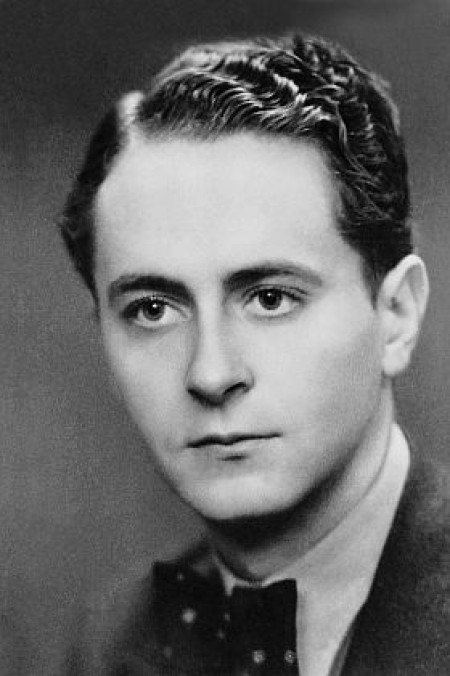
Budapest, 14 November 1913 – Budapest, 7 December 1944
György Faragó appeared in 1936 as a comet in the sky of Hungarian performing art, and after less than a decade of brilliance, in 1944 disappeared just a suddenly as he had arrived. His remarkable artistic talent and attractive personality are preserved by a few recordings and the memories and high praise of his contemporaries.
His piano teacher mother discovered early his special talent: the five-year old boy could play without a score the Bach preludes he had heard from his mother's pupils. At six he was admitted to the National Conservatory and by nine to the second year of the preparatory course of the Music Academy. His talent was not restricted to music. As a child actor, he gave a memorable performance as Nemecsek in the film version made by Béla Balogh of Molnár's Pál utcai fiúk (The boys of Pál street). Later he matriculated with distinction at the Fasori Evangelical Gymnasium (Translator's note: a special school for academically highly talented children).
In his first two years at the Music Academy, and later in the teacher training class, he studied with Arnold Székely, and from the autumn of 1925 with Géza Nagy. Finally, in 1933, in the artists' course, he was Dohnányi's pupil. It was then that Dohnányi made the prediction which later became famous: "The piano department has two candidate artists with a great future: György Faragó and György Cziffra." Besides his piano studies, György Faragó also completed the composition course, as Albert Siklós' pupil, between 1931 and 1935. He received his artist's diploma in 1936, compiling the programme for his diploma concert entirely from works by Liszt: after the Bach fantasy and fugue came the Valée d'Obermann, then four Paganini etudes, and finally the Dante Sonata. The critic of Pesti Hirlap gave the following account of the event: "Faragó proved himself to be not only a musician of surprising talent, but also an excellent Liszt performer. His powerful playing possesses a superior elegance and arresting largesse, the sound effects are so graceful and fine, that they bring Liszt's music very close to the audience. His technique is noticeable polished, the telling way in which keys respond to his touch also marks the forming of the phrases. He plays very clearly, illustratively, but the poetic pictures are not missing from his performance either. We are hardly mistaken in saying that we perceive in György Faragó's concert debut the first step of a brilliant career.".
He achieved his greatest success as a performer in May 1939, when, despite several French pianists competing, he won first prize at the Luxembourg Fauré competition. The rank of the competition is shown by the fact that the jury comprised Richard Strauss, Emil Sauer, Marguerite Long and Francesco Malipiero. Following this victory Faragó received many concert invitations, but fulfilling these became largely impossible because of the outbreak of the war.
The problems of artistic performance interested him not only on the level of daily practice but also in the theoretical sphere. He discussed the matter in a study, A zenei előadás (Musical performance), written in 1943, but published only after his death, in the July 1957 issue of the journal, Vigília. Faragó's starting point is a question that is relevant to this day: "How is the contemporary performer to interpret the works of the last century to meet with approval?" In his answer he formulated his own ars poetica: "The problem of giving a true performance lies in two directions. In its ‘cross section' it is simpler; the conditions for it are great instrumental skill, personal magnetism and suggestive ability, and within that framework the conditions for extreme variations between the intimate lyric and the dramatic moods: the musical primary matter's – harmony, melody and rhythm – intellectual differentiation and integration, and, as the arch, the greatest possible unity of concept and realisation. The longitudinal section of the problem is essentially examining the concept, that is, a stylistic problem: to find the eternal One among the changing endeavours of various ages. To interpret Bach through the approaches of Mendelssohn, Chopin and Liszt, as a romantic interpretation, is perishable. Busoni's transposition aims at the victory of the piano as an instrument over the organ: wasted effort. The terraced dynamic and the would-be imitation of the cembalo negate historic development. Although the performer – thanks to his personal magnetism, for example – can evoke pleasure through one of these means, we can only approve of his production if we can find in it, as the common denominator of all these elements, the endeavour to achieve the eternal One (…)"
From the autumn of 1936 Faragó taught at the National Conservatory, and a year later also at the Music Academy. We are familiar with his teaching method from the accounts of his pupils – among them Mihály Bacher, Ervin László and Emmi Varasdy: Faragó first listened to the piece presented by the student, and then, without any comment, played it himself. The student himself had to recognize and correct his faults. This method, which requires a very high degree of musicality from the student, is similar to that of Faragó's great predecessors, Liszt, Thomán and Dohnányi.
György Faragó could teach at the Music Academy only till January 1941, he was then dismissed because of his Jewish origins. The war, military service, accelerated his illness, as a consequence of which he died in Budapest on 7 December 1944.
A. K.


